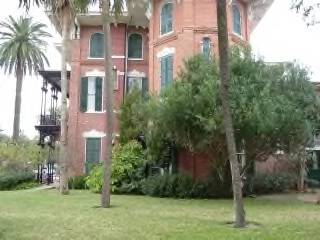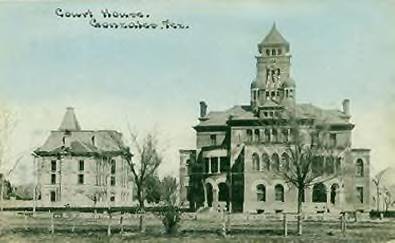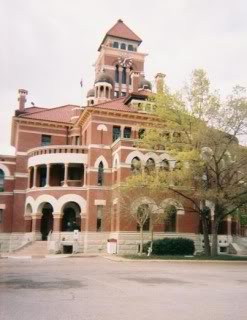
Ashton Villa is one of the architectural showpieces of Galveston, Texas. Located at 2328 Broadway, this splendid three-story Victorian Italianate structure is one of the earliest brick buildings of the island city and one of the earliest brick mansions in Texas. Setting the standard for the stately homes that followed in the posh neighborhood, it was built in 1859 for one of the prominent merchants of the city.
James Moreau Brown was born in Orange County, New York, on September 22, 1821. When he was still a child, his family moved to New York City. Having served (between the ages of twelve and sixteen) an apprenticeship learning the brickmason and plasterers' trades, followed by several years residency throughout the South where he successfully plied his avocation, he arrived in Galveston in 1843. In 1845 he was manufacturing brick on Carpenter's Bayou and thereafter did the brickwork on many of the early commercial buildings of Galveston. In 1847, he entered the hardware business. Following the death of his partner in 1859, he closed the business and became president of the Galveston, Houston and Henderson Railroad, a position he kept through the War Between the States, during which time he also served as a purchasing agent in Mexico. After the war, he resigned as president of the railroad and re-entered the hardware business. The 1870 census placed his financial worth as $175,000 in real estate and $100,000 in personal assets, making him one of the richest men in the state. Brown became involved in numerous other significant professional concerns in subsequent years.
In 1846, Brown married Rebecca Ashton Stoddart of Philadelphia, Pennsylvania. They became the parents of five children, three sons and two daughters. It was in memory of her paternal ancestor, Revolutionary War veteran Isaac Ashton (a lieutenant of the Pennsylvania Artillery) that Mrs. Brown named their new palatial residence "Ashton Villa." Mrs. Brown herself had a namesake in the person of her oldest daughter Rebecca Ashton Brown, who popularly came to be known as "Miss Bettie."
Though he had developed architectural proficiency during his apprenticeship days, Brown used a stock plan for the stately residence, and European craftsmen and slave labor were utilized in its construction. Exterior features included tall windows, ornate verandas, and deep eaves with carved supports. The brick walls were made thirteen inches thick with an airspace left between interior and exterior walls to protect against moisture damage. Constructed on a central hall floor plan, the house features a broad, winding, interior staircase and a large first-floor formal living room, which became known as the Gold Room. Ashton Villa was equiped with indoor plumbing and gasolier lighting.
On Christmas Eve 1895, James Brown died, leaving ownership of the sumptuous villa to his wife Rebecca. During the devastating hurricane that struck Galveston in 1900, described as "the worst recorded natural disaster ever to strike the North American continent," Mrs. Brown is said to have acted to save the home and her family's lives by opening up the doors and windows on the lower floor so that the only negative impact from the 15.7-foot storm-surge over the island was a basement filled with sand, which material also partially buried the six-foot cast iron fence. When the grade of the entire town of Galveston was lifted by as much as seventeen feet with sand pumped from the Gulf floor, the Browns' basement was permanently filled in and the grade of the yard raised, burying much of the fence, which appears now quaintly short.
During its heyday, Ashton Villa was the frequent scene of lavish social events and recitals. Conspicuous at such affairs was the Brown's oldest daughter Bettie. It is through the life (and allegedly the afterlife) of Miss Bettie that much of the fame of Ashton Villa is due.
Bettie Brown was a popular figure of strong will and independent nature. Born in 1855, she grew into a tall beautiful blonde who almost always wore her hair up. She was intelligent, artistic, and fun-loving. In many ways she was even somewhat eccentric. People were surprised, for example, by her smoking in public. At social events held in her home she would often join her guests with kittens riding on the train of her dress. Though she never married, Miss Bettie found no shortage of suitors and seldom if ever was without an admiring escort at the many gala events of the island city. She was an extensive world traveller who often journeyed alone to the far reaches of the world, including Morocco, Jerusalem, Egypt, China, Japan, and India. Artifacts gathered during these travels are exhibited today in the home, adding to its luxury and appeal, as do impressive paintings throughout the house, many of them done by Miss Bettie herself, who studied art in Paris.
Bettie lived most of her life (from the age of four until her death in 1920) in her beloved Ashton Villa, and it is said by many that the mansion is still her spirit's abode. Now a museum, the historic home has been the site of many reported sightings and ghostly happenings. A caretaker residing in the carriage house was awakened from a sound sleep by the sound of a piano playing. Fearing a break-in, he went to investigate. The music was coming from the Gold Room. Expecting to confront a burglar or vandal, he quietly slipped into the room. There at the piano he saw the faint image of a woman in 19th-century attire. A mere moment later, both the figure and the music faded. The caretaker was later quoted as saying that he turned on every light in the house and remained awake for the rest of the night. (A publication of the Galveston Historical Foundation states that "Miss Bettie never learned to play the piano in life?she was an accomplished painter whose works are on display throughout the house?but her sister played both piano and violin." Bettie's only sister, Matilda, was born in 1866.)
From time to time Miss Bettie, dressed in a beautiful turquoise (her favorite color) dress, is seen standing on the second floor landing of the grand staircase. Ceiling fans have been noted to have turned themselves on. In a small upstairs day room a coverlet seems constantly wrinkled as though someone has been resting thereon. A chest of drawers which Miss Bettie purchased in the Middle East, is found to be sometimes locked, sometimes not, though the key to it has long been lost. Miss Bettie is also occasionally seen standing in the Gold Room where furniture moves and inexplicably clocks are stopped. People touring the villa have reported feeling a presence about them. A weekend manager of the museum was quoted in a 1993 newspaper article stating that many of the ghostly activities she observed in 1991 happened on February 18, Miss Bettie's birthday.
Miss Bettie died in 1920. In 1927 a granddaughter of James and Rebecca sold the mansion to the El Mina Shrine. The Shriners used the house for the next forty years as their business offices and for social functions and, in 1968, put the property up for sale. After rumors began to circulate that the edifice would be demolished, the Galveston Historical Foundation, in 1971, purchased Ashton Villa, restored it and located and brought back in the original furnishings and artwork. On July 24, 1974, Ashton Villa was opened to the public. History, however, repeated itself somewhat when in September 2008, resultant to Hurricane Ike, the first floor of the house, with its elaborate ?Gold Room? (parlor and dining room), was flooded with 30 inches of water and mud, soaking the furniture and art. The urgent request for help to save original furniture and artwork was made immediately and quickly acted upon.
Ashton Villa has borne the brunt of time and "tide." Today this stately structure, listed on the National Register of Historic Places, survives to offer us a glimpse of a time and conditions past. Perhaps more, something intangible, survives within its elegant and venerable walls.
Top: Broadway & 24th, Galveston, Tx, looking southwest, in 1910. Bottom: Northeast end of house.







